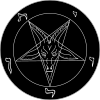
Back شيطانية إلحادية Arabic الشيطانيه الالحاديه ARZ La-Veya satanizmi Azerbaijani Сатанизъм на Ла Вей Bulgarian দার্শনিক শয়তানবাদ Bengali/Bangla LaVeyův satanismus Czech LaVey-satanisme Danish Αθεϊστικός Σατανισμός Greek Satanismo laveyano Spanish LaVey satanism Estonian
 | |
| Founder | |
|---|---|
| Anton Szandor LaVey | |
| Regions with significant populations | |
| Religions | |
| Scriptures | |
| The Satanic Bible | |
| Languages | |
| English | |
| Website | |
| www | |
| Founded 1966 |
LaVeyan Satanism is the name given to the form of Satanism promoted by American occultist and author Anton LaVey (1930–1997). LaVey founded the Church of Satan (CoS) in 1966 in San Francisco. Although LaVey is thought to have had more impact with his Satanic aesthetics of "colourful" rituals and "scandalous" clothes that created a "gigantic media circus",[1] he also promoted his ideas in writings, such as the popular Satanic Bible. LaVeyan Satanism has been classified as a new religious movement and a form of Western esotericism by scholars of religion. LaVey's ideas have been said to weave together an array of sometimes "contradictory"[2] "thinkers and tropes",[2] combining "humanism, hedonism, aspects of pop psychology and the human potential movement", along with "a lot of showmanship",[3] His ideas were heavily influenced by the ideas and writings of Friedrich Nietzsche, Ayn Rand and Arthur Desmond.
Contrary to the popular image of Satanism as the worship of an evil supernatural entity, LaVeyan adherents do not consider Satan to be a literal being or entity, but a positive archetype representing humanity's natural instincts of pride and carnality, and of defiance against Abrahamic religions which preach suppression of these urges. The church considers humans to be animals existing in an amoral universe, and promotes a philosophy based on individualism and egoism, coupled with Social Darwinism and anti-egalitarianism. LaVey valued success, not "evil for its own sake".[4]
Church doctrines are based on materialism and philosophical naturalism, rejecting the existence of the supernatural (including Satan and God), body-soul dualism, and life after death. However, LaVey also "hinted" at the possibility of paranormal forces,[3] and believed magic could and should be used for material gain, personal influence, to harm enemies, and to gain success in love and sex.[5] "Magic" in LaVeyan Satanism involves ritual practice meant as psychodramatic catharsis to focus one's emotional energy for a specific purpose (called "greater magic" and very much resembling psychotherapy); and also psychological manipulation using applied psychology and glamour (or "wile and guile") to bend another individual or a situation to one's will (called "lesser magic").[6][7]
LaVey's followers in the Church of Satan maintain that he and the church "codified" Satanism,[8] and while some Satanic splinter groups — such as John Dewey Allee's First Church of Satan and Karla LaVey's First Satanic Church — follow LaVey's ideas, others do not. The Temple of Set embraces "Theist" supernatural Satanism, while the large and active Satanic Temple, though atheist, rejects LaVey and Ayn Rand's ideas on hierarchy and self-centeredness in favor of a "left-wing",[9] "socially engaged" Satanism,[10] agitating for separation of church and state, reproductive rights, and transgender rights.[9]
- ^ Cite error: The named reference
Andrade-Girardian-LaVey-2020was invoked but never defined (see the help page). - ^ a b Laycock, Satanism, 1981: section 4 The Church of Satan. LaVey’s Satanism
- ^ a b Laycock, Satanism, 1981: section 4 The Church of Satan.
- ^ Taub & Nelson 1993, p. 528.
- ^ van Luijk 2016, pp. 336–337.
- ^ Dyrendal, Lewis & Petersen 2016, p. 86.
- ^ Gardell 2003, p. 289; Petersen 2012, pp. 95–96; Lap 2013, p. 97.
- ^ Ethan, Joel. "The Satanic Temple Fact Sheet". Church of Satan. Retrieved 11 January 2024.
- ^ a b Laycock, Satanism, 2023: 7 Contemporary Developments in Satanism
- ^ J. P. Laycock, Speak of the Devil: How the Satanic Temple Is Changing the Way We Talk about Religion (New York: Oxford University Press, 2020)
© MMXXIII Rich X Search. We shall prevail. All rights reserved. Rich X Search